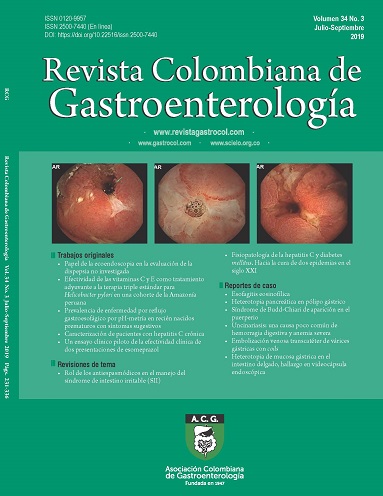Efectividad de las vitaminas C y E como tratamiento adyuvante a la terapia triple estándar para Helicobacter pylori en una cohorte de la Amazonía Peruana
DOI:
https://doi.org/10.22516/25007440.292Palabras clave:
Ácido ascórbico, Vitamina E, drug therapy, Helicobacter pylori, PerúResumen
Introducción y objetivos: la terapia con vitaminas C y E ha sido propuesta como adyuvante a la terapia triple estándar (TTE) con el fin de incrementar la tasa de erradicación del Helicobacter pylori (H. pylori). En este estudio probamos esta hipótesis en una cohorte de pacientes de la Amazonía peruana.
Materiales y métodos: retrospectivamente, evaluamos una cohorte de 50 pacientes infectados con H. pylori del Hospital de Tarapoto en el período comprendido entre julio-diciembre de 2016; de estos, 25 fueron tratados con TTE (amoxicilina 1 g, claritromicina 500 mg y omeprazol 20 mg, dos veces al día por 14 días) en adyuvancia con las vitaminas C y E, y 25 fueron tomados al azar (1:1), quienes solo recibieron TTE. Se estimó y comparó la efectividad de ambos tratamientos utilizando un modelo regresión general lineal con familia Poisson y link log, teniendo como desenlace de interés la erradicación del H. pylori confirmada por histopatología.
Resultados: al comparar la cohorte de expuestos y con los no expuestos, no se encontraron diferencias significativas en sus características basales, incluyendo edad (38 ± 11 frente a 36 ± 10 años), género masculino (65 % frente a 63 %), síntomas y diagnóstico histopatológico. Al comparar la efectividad de ambos tratamientos, se encontró un incrementó no significativo en las tasas de erradicación del 9,5 % (91 % frente a 82 %, razón de tasas de incidencia = 1,11; intervalo de confianza [IC] 95 %: 0,92 a 1,36).
Conclusiones: la terapia adyuvante con vitaminas C y E podría ayudar a incrementar la efectividad de la TTE para H. pylori en pacientes de la Amazonía peruana, aunque se requiere confirmar esta hipótesis en un ensayo clínico.
Descargas
Referencias bibliográficas
Hooi JKY, Lai WY, Ng WK, Suen MMY, Underwood FE, Tanyingoh D, et al. Global Prevalence of Helicobacter pylori Infection: Systematic Review and Meta-Analysis. Gastroenterology. 2017 Aug;153(2):420-429. https://doi.org/10.1053/j.gastro.2017.04.022
Zamani M, Ebrahimtabar F, Zamani V, Miller WH, Alizadeh-Navaei R, Shokri-Shirvani J, et al. Systematic review with meta-analysis: the worldwide prevalence of Helicobacter pylori infection. Aliment Pharmacol Ther. 2018 Apr;47(7):868-876. https://doi.org/10.1111/apt.14561
Suzuki H. Helicobacter pylori-Associated Upper Gastrointestinal Symptoms: FD or HpD? Dig Dis Sci. 2017 Jun;62(6):1391-1393. https://doi.org/10.1007/s10620-017-4556-4
Schistosomes, liver flukes and Helicobacter pylori. IARC Working Group on the Evaluation of Carcinogenic Risks to Humans. Lyon, 7-14 June 1994. IARC Monogr Eval Carcinog Risks Hum. 1994;61:1-241.
Fallone CA, Chiba N, van Zanten SV, Fischbach L, Gisbert JP, Hunt RH, et al. The Toronto Consensus for the Treatment of Helicobacter pylori Infection in Adults. Gastroenterology. 2016 Jul;151(1):51-69.e14. https://doi.org/10.1053/j.gastro.2016.04.006
Gisbert JP, Calvet X. Review article: the effectiveness of standard triple therapy for Helicobacter pylori has not changed over the last decade, but it is not good enough. Aliment Pharmacol Ther. 2011 Dec;34(11-12):1255-68. https://doi.org/10.1111/j.1365-2036.2011.04887.x
Novoa Reyes I, Caravedo Martínez M, Huerta-Mercado TJ, De los Ríos Senmache R, Pinto Valdivia J, Bussalleu Rivera A. Recurrencia de la infección gástrica con Helicobacter pylori en adultos peruanos con distrés postprandial dos años después de la erradicación exitosa. Rev Gastroenterol del Perú. 2014;34(1):15-21.
Malfertheiner P, Megraud F, O’Morain CA, Gisbert JP, Kuipers EJ, Axon AT, et al. Management of Helicobacter pylori infection-the Maastricht V/Florence Consensus Report. Gut. 2017 Jan;66(1):6-30. https://doi.org/10.1136/gutjnl-2016-312288
Sezikli M, Cetinkaya ZA, Sezikli H, Güzelbulut F, Tiftikçi A, Ince AT, et al. Oxidative stress in Helicobacter pylori infection: does supplementation with vitamins C and E increase the eradication rate? Helicobacter. 2009 Aug;14(4):280-5. https://doi.org/10.1111/j.1523-5378.2009.00686.x
Zhang ZW, Abdullahi M, Farthing MJ. Effect of physiological concentrations of vitamin C on gastric cancer cells and Helicobacter pylori. Gut. 2002 Feb;50(2):165-9. https://doi.org/10.1136/gut.50.2.165
Zhang ZW, Farthing MJ. The roles of vitamin C in Helicobacter pylori associated gastric carcinogenesis. Chin J Dig Dis. 2005;6(2):53-8. https://doi.org/10.1111/j.1443-9573.2005.00194.x
Traber MG, Stevens JF. Vitamins C and E: beneficial effects from a mechanistic perspective. Free Radic Biol Med. 2011 Sep 1;51(5):1000-13. https://doi.org/10.1016/j.freeradbiomed.2011.05.017
Sugimoto N, Yoshida N, Nakamura Y, Ichikawa H, Naito Y, Okanoue T, et al. Influence of vitamin E on gastric mucosal injury induced by Helicobacter pylori infection. Biofactors. 2006;28(1):9-19. https://doi.org/10.1002/biof.5520280102
Everett SM, Drake IM, White KL, Mapstone NP, Chalmers DM, Schorah CJ, et al. Antioxidant vitamin supplements do not reduce reactive oxygen species activity in Helicobacter pylori gastritis in the short term. Br J Nutr. 2002 Jan;87(1):3-11. https://doi.org/10.1079/BJN2001477
Li G, Li L, Yu C, Chen L. Effect of vitamins C and E supplementation on Helicobacter pylori eradication: a meta-analysis. Br J Nutr. 2011 Dec;106(11):1632-7. https://doi.org/10.1017/S0007114511003813
Sezikli M, Cetinkaya ZA, Güzelbulut F, Sezikli H, Özkara S, Coşgun S, et al. Efficacy of vitamins supplementation to therapy on Helicobacter pylori eradication in patients with low antioxidant capacity. Clin Res Hepatol Gastroenterol. 2011 Nov;35(11):745-9. https://doi.org/10.1016/j.clinre.2011.07.001
Hudak L, Jaraisy A, Haj S, Muhsen K. An updated systematic review and meta-analysis on the association between Helicobacter pylori infection and iron deficiency anemia. Helicobacter. 2017 Feb;22(1). https://doi.org/10.1111/hel.12330
Franceschi F, Annalisa T, Teresa DR, Giovanna D, Ianiro G, Franco S, et al. Role of Helicobacter pylori infection on nutrition and metabolism. World J Gastroenterol. 2014 Sep 28;20(36):12809-17. https://doi.org/10.3748/wjg.v20.i36.12809
Alcázar L. Impacto económico de la anemia en el Perú. Lima: GRADE; Acción contra el Hambre; 2012. p. 19-24.
Tarqui-Mamani C, Sanchez-Abanto J, Alvarez-Dongo D, Espinoza-Oriundo P, Jordan-Lechuga T. Prevalencia de anemia y factores asociados en adultos mayores peruanos. Rev Peru Med Exp Salud Pública. 2015;32(4):687-92. https://doi.org/10.17843/rpmesp.2015.324.1759
Lane DJ, Jansson PJ, Richardson DR. Bonnie and Clyde: Vitamin C and iron are partners in crime in iron deficiency anaemia and its potential role in the elderly. Aging (Albany NY). 2016 May;8(5):1150-2. https://doi.org/10.18632/aging.100966
Sezikli M, Çetinkaya ZA, Güzelbulut F, Çimen B, Özcan Ö, Özkara S, et al. Effects of alpha tocopherol and ascorbic acid on Helicobacter pylori colonization and the severity of gastric inflammation. Helicobacter. 2012 Apr;17(2):127-32. https://doi.org/10.1111/j.1523-5378.2011.00925.x
Hagag AA, Amin SM, El-Fiky RB, El-Sayad ME. Study of Serum Levels of Some Oxidative Stress Markers in Children with Helicobacter pylori Infection. Infect Disord Drug Targets. 2018;18(1):52-59. https://doi.org/10.2174/1871526517666170102115116
Pareja Cruz A, Navarrete Mejía PJ, Parodi García JF. Seroprevalencia de infección por Helicobacter pylori en población adulta de Lima, Perú 2017. Horizonte Médico. 2017;17(2):55-8. https://doi.org/10.24265/horizmed.2017.v17n2.08.
Tümgör G, Baran M, Çakır M, Yüksekkaya HA, Aydoğdu S. Comparison of standard and standard plus vitamin E therapy for Helicobacter pylori eradications in children. Turk J Gastroenterol. 2014 Dec;25 Suppl 1:99-103. https://doi.org/10.5152/tjg.2014.5592
Demirci H, Uygun İlikhan S, Öztürk K, Üstündağ Y, Kurt Ö, Bilici M, et al. Influence of vitamin C and E supplementation on the eradication rates of triple and quadruple eradication regimens for Helicobacter pylori infection. Turk J Gastroenterol. 2015 Nov;26(6):456-60. https://doi.org/10.5152/tjg.2015.0233
Sezikli M, Çetinkaya ZA, Güzelbulut F, Yeşil A, Coşgun S, Kurdaş OÖ. Supplementing vitamins C and E to standard triple therapy for the eradication of Helicobacter pylori. J Clin Pharm Ther. 2012 Jun;37(3):282-5. https://doi.org/10.1111/j.1365-2710.2011.01286.x
Bui D, Brown HE, Harris RB, Oren E. Serologic Evidence for Fecal-Oral Transmission of Helicobacter pylori. Am J Trop Med Hyg. 2016 Jan;94(1):82-8. https://doi.org/10.4269/ajtmh.15-0297
Castillo Contreras O, Maguiña Quispe J, Benites Goñi H, Chacaltana Mendoza A, Guzmán Calderón E, Dávalos Moscol M, et al. Prevalencia de Helicobacter pylori en pacientes sintomáticos de consulta externa de la Red Rebagliati (EsSalud), Lima, Perú, en el período 2010-2013. Rev Gastroenterol Perú. 2016;36(1):49-55.
Wex T, Venerito M, Kreutzer J, Götze T, Kandulski A, Malfertheiner P. Serological prevalence of Helicobacter pylori infection in Saxony-Anhalt, Germany, in 2010. Clin Vaccine Immunol. 2011 Dec;18(12):2109-12. https://doi.org/10.1128/CVI.05308-11
Zhang M, Zhou YZ, Li XY, Tang Z, Zhu HM, Yang Y, Chhetri JK. Seroepidemiology of Helicobacter pylori infection in elderly people in the Beijing region, China. World J Gastroenterol. 2014 Apr 7;20(13):3635-9. https://doi.org/10.3748/wjg.v20.i13.3635
Boehnke KF, Brewster RK, Sánchez BN, Valdivieso M, Bussalleu A, Guevara M, et al. An assessment of drinking water contamination with Helicobacter pylori in Lima, Peru. Helicobacter. 2018 Apr;23(2):e12462. https://doi.org/10.1111/hel.12462
Ramírez A, Chinga E, Mendoza D. Variación de la prevalencia del H. Pylori y su relación con los niveles de cloro en el agua de la Atarjea, Lima, Perú: Período 1985-2002. Rev Gastroenterol Perú. 2004;24(3):223-9.
Descargas
Publicado
Cómo citar
Número
Sección
Licencia
Aquellos autores/as que tengan publicaciones con esta revista, aceptan los términos siguientes:
Los autores/as ceden sus derechos de autor y garantizarán a la revista el derecho de primera publicación de su obra, el cuál estará simultáneamente sujeto a la Licencia de reconocimiento de Creative Commons que permite a terceros compartir la obra siempre que se indique su autor y su primera publicación en esta revista.
Los contenidos están protegidos bajo una licencia de Creative Commons Reconocimiento-NoComercial-SinObraDerivada 4.0 Internacional.



















